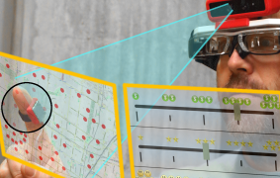« Back to Publications list
Combining Ring Input with Hand Tracking for Precise, Natural Interaction with SAIs
Download Publication File
Abstract
Current wearable interfaces are designed to support short-duration tasks known as micro-interactions. To support productive interfaces for everyday analytic tasks, designers can leverage natural input methods such as direct manipulation and pointing. Such natural methods are now available in virtual, mobile environments thanks to miniature depth cameras mounted on head-worn displays (HWDs). However, these techniques have drawbacks, such as fatigue and limited precision. To overcome these limitations, we explore combined input: hand tracking data from a head-mounted depth camera, and input from a small ring device. We demonstrate how a variety of input techniques can be implemented using this novel combination of devices. We harness these techniques for use with Spatial Analytic Interfaces: multi-application, spatial UIs for in-situ, analytic taskwork on wearable devices. This research demonstrates how combined input from multiple wearable devices holds promise for supporting high-precision, low-fatigue interaction techniques, to support Spatial Analytic Interfaces on HWDs.
Video
Publisher Link
http://dx.doi.org/10.1145/2983310.2985757
Citation
Barrett Ens, Ahmad Byagowi, Teng Han, Juan David Hincapié-Ramos, Pourang Irani. 2016. Combining Ring Input with Hand Tracking for Precise, Natural Interaction with SAIs. In Proceedings of the 4th symposium on Spatial User Interactions (SUI '16), Tokyo, Japan. ACM, to appear.

Authors

Barrett Ens
Alumni
Teng Han
Alumni
Pourang Irani
ProfessorCanada Research Chair
at University of British Columbia Okanagan Campus
As well as: Ahmad Byagowi


